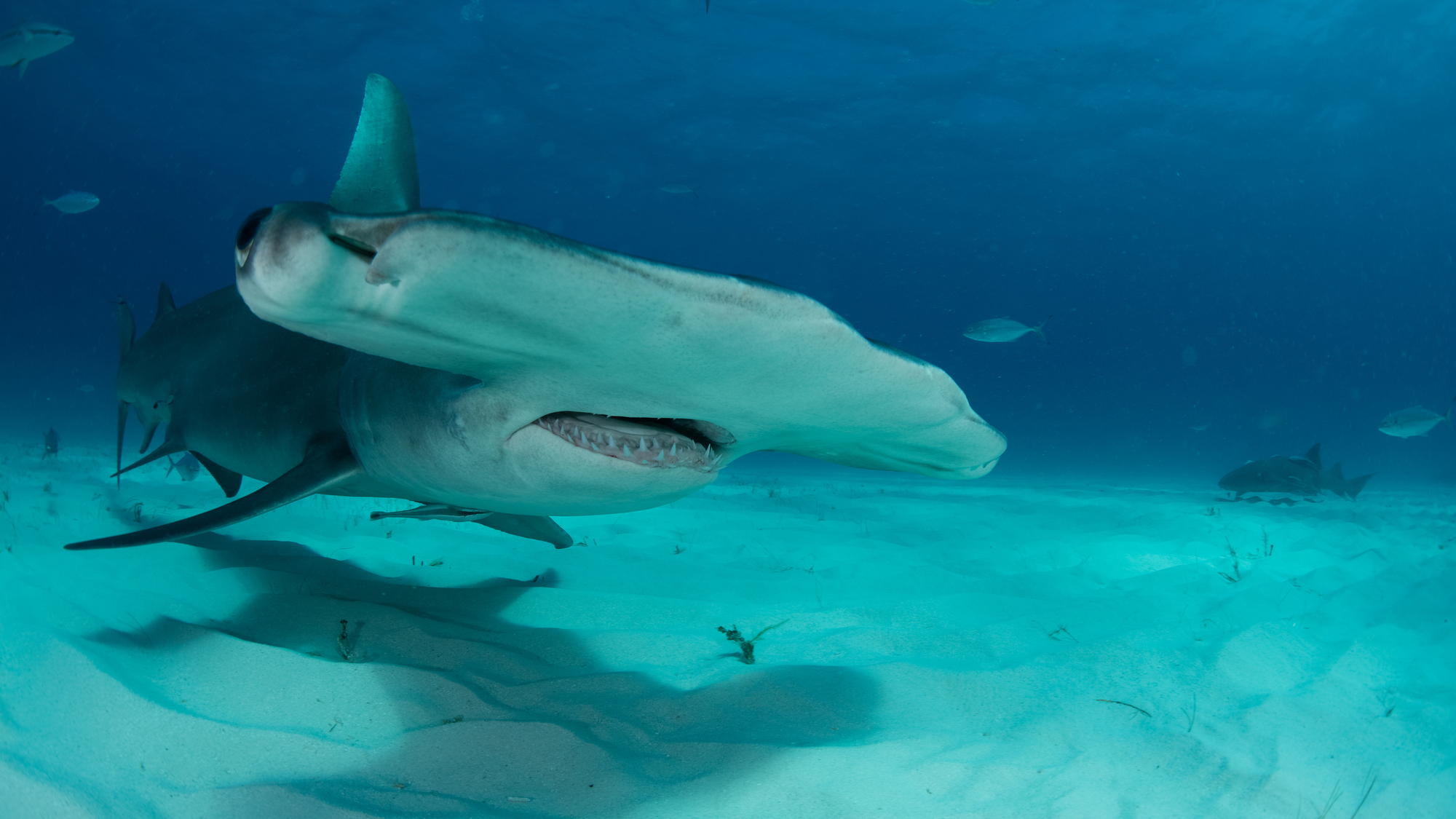Gadgets
A scientific mission to save the sharks

This article was originally featured on Knowable Magazine.
A hammerhead shark less than one meter long swims frantically in a plastic container aboard a boat in the Sanquianga National Natural Park, off Colombia’s Pacific coast. It is a delicate female Sphyrna corona, the world’s smallest hammerhead species, and goes by the local name cornuda amarilla — yellow hammerhead — because of the color of its fins and the edges of its splendid curved head, which is full of sensors to perceive the movement of its prey.
Marine biologist Diego Cardeñosa of Florida International University, along with local fishermen, has just captured the shark and implanted it with an acoustic marker before quickly returning it to the murky waters. A series of receivers will help to track its movements for a year, to map the coordinates of its habitat — valuable information for its protection.
That hammerhead is far from the only shark species that keeps the Colombian biologist busy. Cardeñosa’s mission is to build scientific knowledge to support shark conservation, either by locating the areas where the creatures live or by identifying, with genetic tests, the species that are traded in the world’s main shark markets.
Sharks are under threat for several reasons. The demand for their fins to supply the mainly Asian market (see box) is a very lucrative business: Between 2012 and 2019, it generated $1.5 billion. This, plus their inclusion in bycatch — fish caught unintentionally in the fishing industry — as well as the growing market for shark meat, leads to the death of millions every year. In 2019 alone the estimated total killed was at least 80 million sharks, 25 million of which were endangered species. In fact, in the Hong Kong market alone, a major trading spot for shark fins, two-thirds of the shark species sold there are at risk of extinction, according to a 2022 study led by Cardeñosa and molecular ecologist Demian Chapman, director of the shark and ray conservation program at Mote Marine Laboratory in Sarasota, Florida.
Sharks continue to face a complicated future despite decades of legislation designed to protect them. In 2000, the US Congress passed the Shark Finning Prohibition Act, and in 2011 the Shark Conservation Act. These laws require that sharks brought ashore by fishermen have all their fins naturally attached and aim to end the practice of stripping the creatures of their fins and returning them, mutilated, to the water to die on the seafloor. Ninety-four other countries have implemented similar regulations.
Perhaps the main political and diplomatic tool for shark conservation is in the hands of the Convention on International Trade in Endangered Species of Wild Fauna and Flora (CITES), composed of 183 member countries plus the European Union. The treaty offers three degrees of protection, or appendices, to more than 40,000 species of animals and plants, imposing prohibitions and restrictions on their trade according to their threat status.
Sharks were included in CITES Appendix II — which includes species that are not endangered but could become so if trade is not controlled — in February 2003, with the addition of two species: the basking shark (Cetorhinus maximus) and the whale shark (Rhincodon typus). Following that, the list of protected species grew to 12 and then increased significantly in November 2023 with the inclusion of 60 more species of sharks in CITES Appendix II.
But do these tools actually protect sharks? To seek out answers, over the past decade researchers have worked to develop tests that can easily identify which species of sharks are being traded — and determine whether protected species continue to be exploited. They have also focused on studying shark populations around the world in order to provide information for the establishment of protected areas that can help safeguard these animals.
Which shark does that fin belong to?
The port of Hong Kong, along with the Chinese city of Guangzhou, is one of the world’s major centers for the trade in shark fins, considered by many Chinese communities to be a delicacy, often served in soup. Hong Kong serves as a legal importer, re-exporter and consumer of these cartilages, both fresh and packaged in bags of trimmings. A decade ago, Cardeñosa, Chapman and other members of their team began an investigation there, with the goal of answering a question: Are protected shark species being exploited?
Many fins look the same, making it difficult to know whether they belong to CITES Appendix II-listed sharks. But the scientists were confident that, with the use of genetic analysis tools, their question could be answered.

After scouring a market that stretches for several blocks of storefronts cluttered with bags and jars of yellowed shark fin clippings, Cardeñosa returned to his lab in Florida with several randomly chosen bundles. The challenge, then, was to develop the analysis for molecular identification in the dead material. “The problem is that processed fins have degraded DNA, preventing their identification with established protocols,” Cardeñosa explains. “Genetic approaches to identify shark products exist, but they typically rely on sequencing large regions of DNA, which can fail when working with highly processed products.”
So Cardeñosa, Chapman and other colleagues developed a new test, using a technique known as DNA barcoding, that reads short pieces of DNA sequences to detect what species of shark is in a sample. It works not only on fin pieces but also on cooked shark fin soup and cosmetic products made of shark liver oil.
DNA barcoding technology uses small segments of the cytochrome c oxidase I gene, COI, as molecular tags. Each animal species has its own label or barcode of those DNA segments, and forensic geneticists compare the DNA sequences of the sample with a database of genomic sequences from living animals.
The method designed by Cardeñosa and colleagues is more effective than the original barcoding technology because, instead of having to use all 650 DNA base pairs of the COI gene to serve as a species barcode, the test can identify a species with just 150 base pairs — in effect, a mini-barcode. The test also simultaneously analyzes several mini-barcodes or the COI gene for each species, instead of just one. This makes it easier to identify the species in highly processed products, even in a bowl of soup.
During four years of using that protocol on 9,200 fin clippings purchased in Hong Kong, Cardeñosa and colleagues showed that the species most traded for their fins included sharks listed on CITES Appendix II — specifically, several species of the family Sphyrnidae, which includes hammerhead sharks, as well as the blue shark (Prionace glauca).

To make it simpler to identify shark species being traded, Cardeñosa and Chapman decided to bring the lab to port. In 2018, they published in Nature the design of a portable lab for rapid, on-site DNA analysis: In a single reaction that takes less than four hours, it can detect nine of the 12 shark species that were listed on CITES Appendix II at that time. “It’s a PCR or polymerase chain reaction test, just like a Covid test,” Chapman explains, but instead of detecting fragments of viral genetic material, it detects fragments of the COI gene, which are different in DNA sequence for each of the nine shark species. It is easy to use, and therefore suitable for port officials, and costs 94 cents per sample, making it affordable even for low-income countries.
Now that there are more than 70 species of sharks under CITES protection, more powerful tools will be needed to identify protected species among the materials being traded. Chapman is working with the company Ecologenix, which has developed a modification to the PCR test that allows it to identify many species at once.
Ecologenix’s development is based on a technology called FastFish-ID, which was created to identify bony fish. A small-scale study in Indonesia showed that the technology can be adapted for use in cartilaginous fish like sharks. The identification technique also makes use of the COI gene but incorporates fluorescent dyes and machine learning into the PCR procedure to help recognize species. Although it is more expensive — at $10 per test — it is more powerful because it can identify many more species at once.
Protecting sharks’ homes
Genetic analysis not only allows scientists to know what type of shark the fin or meat being traded belongs to, it can also tell them where the animal comes from geographically. Hammerheads are especially suited to these studies, not only because the DNA database that exists on them is so extensive, but also because they tend to return to breed in the place where they were born.


-

 Destination8 months ago
Destination8 months agoSingapore Airlines CEO set to join board of Air India, BA News, BA
-

 Breaking News10 months ago
Breaking News10 months agoCroatia to reintroduce compulsory military draft as regional tensions soar
-

 Gadgets3 months ago
Gadgets3 months agoSupernatural Season 16 Revival News, Cast, Plot and Release Date
-

 Tech News12 months ago
Tech News12 months agoBangladeshi police agents accused of selling citizens’ personal information on Telegram
-

 Productivity11 months ago
Productivity11 months agoHow Your Contact Center Can Become A Customer Engagement Center
-

 Gadgets3 weeks ago
Gadgets3 weeks agoFallout Season 2 Potential Release Date, Cast, Plot and News
-

 Breaking News10 months ago
Breaking News10 months agoBangladesh crisis: Refaat Ahmed sworn in as Bangladesh’s new chief justice
-

 Toys12 months ago
Toys12 months ago15 of the Best Trike & Tricycles Mums Recommend






















